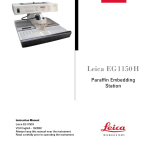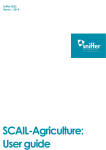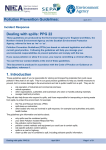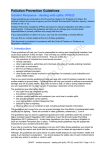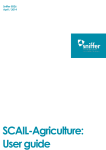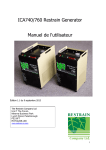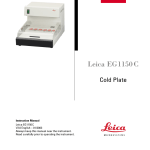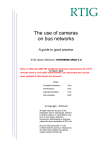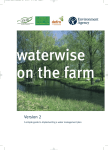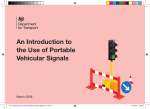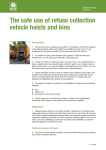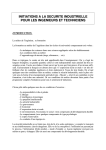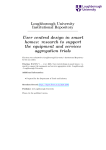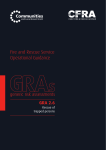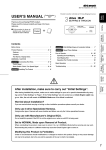Download Reducing Fire Risk at Sites Storing Combustible Materials
Transcript
Reducing fire risk at sites storing combustible materials: Technical Guidance Note (TGN7.01) Contents 1. 2. 3. 4. 5. 6. 7. 8. 9. 10. 11. 12. 1 Introduction Key points What’s the consequence of a fire? What’s the risk of fire on your site? Preventing fires Detecting and suppressing fires Containing and mitigating the effect of fires Managing stacks Producing an accident plan Checklists Glossary References 2 3 4 5 6 8 9 10 13 16 18 19 How to comply with your environmental permit – reducing fire risk on sites storing combustible materials 1. Introduction In How to comply with your environmental permit: http://publications.environmentagency.gov.uk/pdf/GEHO0812BUST-E-E.pdf we describe the measures permitted sites must take to minimise pollution and harm to health. This includes the implementation of a written management system to deliver the conditions within the permit. Fully implementing a satisfactory management system provides appropriate protection for the environment and local community. Part of the management system includes the accident plan. This Technical Guidance Note (TGN) sets out what needs to be captured within that accident plan to reduce fire risk on permitted sites storing combustible materials including waste treatment and recovery facilities. This guidance applies to site storing more than 50 cubic metres of solid combustible material at any one time, in the absence of: • • a relevant sector fire code of practice, recognised by us and or another appropriate professional regulatory body an accident plan, which has been assessed and agreed with your local Fire and Rescue Service If you don’t follow this guidance or appropriate sector specific guidance, you should be able to justify why not and show that the site specific measures you’ve taken instead are equivalent or superior. If your permit does not have a condition requiring a written management system, you should still follow this guidance. If you don’t, we may take appropriate action, for example varying your permit. This TGN supplements but doesn’t replace any statutory requirements for sites controlled under Local Acts of Parliament, the Regulatory Reform (Fire Safety) Order 2005 or other applicable legislation. This guidance describes how to: • assess the risks posed from fires involving combustible materials in stacks and piles • identify sites where this guidance should be applied • identify the measures that should be included in your accident plan and implemented at all times to reduce the risk of fire and fire spread • produce an accident plan which you can share with your local Fire and Rescue Service (FRS) • store combustible waste with appropriate stack sizes and separation distances • determine appropriate fire fighting strategies and ways to minimise impacts of a fire on people, property and the environment. It applies to all combustible materials including (but not limited to): • paper or cardboard • plastics • rubber, natural or synthetic, including whole tyres, baled tyres, tyre shred, crumb and fibre • wood, whether or not scrap or cut into planks, boards, logs, firewood or chips, or joined to form crates, pallets, casks or barrels • fragmentiser waste (from vehicle dismantling) • rags • Refuse Derived Fuel (RDF) and Solid Derived Fuel (SRF) 2 How to comply with your environmental permit – reducing fire risk on sites storing combustible materials • waste electrical and electronic equipment such as fridges, computers and televisions containing combustible materials such as plastic You should also take action to reduce the risk from stacks of combustible materials enclosed by any buildings on your site. Much of the guidance in this document will be relevant to enclosed stacks, but, due to differences in the type, size and construction of buildings that could be used to store combustible materials, you should additionally seek and follow the advice of your local FRS. In England and Wales, you must also comply with the Regulatory Reform (Fire Safety) Order 2005 (RRO)) [Section12, reference 1]. This guidance does not apply to landfill sites or to the storage of: • compost • animal manures and bedding • flammable materials • combustible liquids • dangerous substances stored under the Control of Major Accident Hazards (COMAH) Regulations For the other materials and activities not listed above, please contact the Health and Safety Executive (HSE), your local FRS, or us for advice. 2. Key Points Fires involving combustible materials can cause significant harm to people and the environment, i.e.• combustion products, even those from non-toxic materials release airborne pollutants; which can cause both short and long term effects on human health and the environment • firewater run-off can transport pollutants into drainage systems, rivers and lakes, groundwater and soil, threatening water supplies, public health, wildlife and recreational use • thermal radiation harms people and the environment and can lead to fire spread • hazardous waste will be created by the fire and the impacts of fire fighting • explosions and projectiles can harm people and spread the fire to unaffected areas • fire can threaten life and cause property damage The impact of a fire may be both immediate and long lasting and can present a significant burden for the FRS, other agencies and the public – including the risk of death, and harm to public health. Dealing with a waste fire is likely to involve a large number of fire appliances and fire fighters, which are funded by the tax payer. If you’re the polluter, you are likely to be responsible for the costs of any clean up. This can be expensive, as in many cases the solid remains of combustion products and partially burnt material is classified as hazardous waste. There may be other costs associated with our and other responders’ incident response and/or fines or costs through the criminal and/or civil courts. Your company’s business reputation may suffer and your insurance costs are likely to rise. Being a good neighbour is about thinking about the impact a fire may have on your neighbourhood and local community. 3 How to comply with your environmental permit – reducing fire risk on sites storing combustible materials You should consider the following points to prevent or reduce the risk from a fire. Identify sites where this guidance should be applied What can you do to reduce fire risk? What should be included in your accident plan? Assess fire risk on each site Section 4 • • • prevent detect/suppress contain/mitigate Sections 5-7 • • • • • • minimum separation distances maximum stack sizes other stack size separation site layout water supplies alternative approaches. Section 8 • What you are doing to reduce fire risk – specific actions to manage all above • If a fire starts - what you will do before your local FRS arrive • What you will do after your local FRS arrive Section 9 Use our checklist to help you prevent a fire at your site and to minimise it’s impact, if one starts. Section 10 3. What’s the consequence of a fire? 3.1 Causes of fires Causes of fires on your site can include: • • • • • • • • • • • • • • • 4 arson or vandalism self combustion, e.g. due to chemical oxidation, microbial decomposition plant or equipment failure electrical faults naked lights discarded smoking materials hot works, e.g. welding, cutting industrial heaters hot exhausts open burning on site or nearby damaged/exposed electrical cables reactions between incompatible materials neighbouring site activities sparks from loading buckets ‘hot’ loads deposited at the site How to comply with your environmental permit – reducing fire risk on sites storing combustible materials 3.2 Fire characteristics The type of combustible materials on your site and how they’re stored will influence the size, intensity and duration of any fire. Fires in large stacks, particularly those made up of finely divided materials can be particularly difficult to extinguish. Direct application of water, with or without fire fighting additives such as foam, to burning stacks of these materials is often ineffective and may generate large volumes of polluted firewater and/or more smoke. Stacks of these materials can burn for many weeks or months, with significant impact on local communities. 4. What’s the risk of fire on your site? If you store combustible materials on your site, the three components below need to be present for your site to pose a risk to people and/or environment: ‘source - pathway – receptor’. a source of pollution1 such as contaminated fire water run-off, toxic smoke plume a pathway pollution travels through a receptor pollution affects such as surface drains, permeable ground, air such as a river, groundwater, local populations You must review or produce a risk assessment and ensure that it considers: • the location of your site • which and how many sensitive receptors including schools, hospitals, major transport infrastructure, others businesses, shops, residential areas, rivers, canals and protected habitats are within 1km of your site • the type and quantity of materials you store • what would happen to these materials in a fire • the potential causes and likelihood of fire • your water supplies and fire fighting options, including a controlled burn • environmental pathways • the presence or absence of firewater containment facilities • prevailing wind direction and measures you have taken to counter it: e.g. bunds and wind-breaks. 1 “pollution”, other than in relation to a water discharge activity or groundwater activity, means any emission as a result of human activity which may— (a) be harmful to human health or the quality of the environment (b) cause offence to a human sense (c) result in damage to material property, or (d) impair or interfere with amenities or other legitimate uses of the environment 5 How to comply with your environmental permit – reducing fire risk on sites storing combustible materials How to Comply with your environmental permit has more information on conducting a risk assessment. ‘Controlled Burn: PPG28’ [Section12, reference 2] gives advice on how to assess the risk and applies to all sites, not just those where a controlled burn is relevant. Where your assessment indicates that fire is a risk to sensitive receptors within 1km of your site, then you must work with your local FRS and us, to reduce the risk and consequences to an acceptable level. There are three main ways to do this: • preventing • detecting and suppressing • containing and mitigating These are described further in the next sections. 5. Preventing fires Ensuring everything possible is done to prevent fires is the most important part of the accident plan. You must: • control sources of ignition such as heating pipes, naked flames, light bulbs, space heaters furnaces/incinerators; o o keep these at least 6 meters away from stacks of combustible and flammable materials reinforce the message using signs • ensure staff and any contractors follow safe working practice when undertaking hot working, such as welding and cutting, • ensure all visitors are aware of the correct safety and fire prevention procedures to follow whilst on site • apply a no smoking policy or ensure designated smoking areas are situated away from combustible materials. • introduce a regular maintenance and inspection programme for all site areas including site machinery and ensure good house-keeping, e.g. keeping levels of dust, fibre and paper in buildings and around the site to a minimum • put site security measures in place; such as security fencing, intruder alarms and CCTV, to prevent arson. Your arrangements should cover both the working day and outside normal hours • have all site vehicles fitted with fire extinguishers and dust filters • have all bucket loaders fitted with rubber strips to prevent sparks being generated when the bucket comes into contact with hard-standing etc. You should: • 6 consider implementing a fire-watch at the end of the shift (when dust from processing operations can settle onto hot exhausts / engine parts), and also for separation distances to be observed between plant & material when the site is not staffed How to comply with your environmental permit – reducing fire risk on sites storing combustible materials • consider the provision of an ‘emergency / quarantine area’. This must be kept available at all times for use if a hot load is imported, or if a hot-spot is identified in a stockpile and turning or digging out to isolate are considered suitable measures. Such an area would require suitable separation distances to be maintained around it when in use, and must not obstruct exit routes etc., as it would be very high risk 5.1 Self Combustion Some materials can spontaneously combust under certain conditions, and the risk increases when materials are stored for prolonged periods. You must ensure that the following materials are not stored on site for longer than 6 months: • green material, wood and wood products, general waste including RDF and fines • smaller size/graded materials either stored or mixed • material that has not been checked for potential hazards before stocking; e.g. exposed metal rusts (which can generate heat, or treated materials aren’t cooled enough before storage – treatment process can generate heat – particularly if blades are blunt) • larger than recommended stacks are employed You can prevent spontaneous combustion if you focus on separation, isolation, restricting storage times and keeping materials as cool as possible. You must use a clear recording method to show how long all materials have been on site and ensure you have robust waste acceptance procedures that prevent unauthorised waste being accepted. Where appropriate you should: • reduce l risk factors, e.g. exposed metal content, proportion of 'fines', mixing of materials, heat generated during treatment • minimise stack size wherever possible – a number of small stacks are safer than one big one • control moisture levels • manage stock levels to prevent piles being left for long periods • use older materials first • keep material in its largest form prior to processing for its end market • monitor sub-surface temperature with a thermal lance • Ensure you understand how to deal with hot spots and consider regular turning of piles at risk of spontaneous heating (for example older piles) minimise external heating e.g. shade from direct sunshine 5.2 Enclosing Stacks You may wish to consider enclosing your stock-piles. This is not a straightforward decision as there are advantages and disadvantages with each approach. 7 How to comply with your environmental permit – reducing fire risk on sites storing combustible materials You should consider the following factors: • • • • • • • the effect on being able to achieve full stock rotation protection from wind the material used to enclose the stockpile, for example metal sheets could increase the risks as they absorb heat from sunlight stock capacity ability to ensure segregation of materials increased prevention from transmission of fire between stockpiles (are the walls of sufficient size, and what is their construction?) the ability of the FRS to fight or contain the fire In general you should aim to strike a balance between allowing moisture to escape, which is helpful because it stabilises the stack; and enclosing the stack, which is also helpful because it reduces ventilation. A 3-sided covered building may provide the best compromise, but it will be advisable to discuss the question with your local FRS and us. 5.3 Turning of Stacks You should also consider whether to turn or not turn your stacks. Turning will allow excess heat to dissipate and will reduce any local areas of high moisture, but can cause a fire which is already smouldering to flare, because it allows oxygen to enter the stack. Regular turning of these stacks is recommended and it is imperative that site staff understand the appropriate way to manage hot spots. How to detect and manage hotspots must be included in the accident plan. Stacks should therefore be monitored regularly for temperature build-up. The longer any stack of materials that can self combust is left the more prone it is to self-combustion and therefore the more closely it should be monitored. The document on spontaneous heating of piled tyre shred and rubber crumb [Section12, reference 3], provides further advice on how you can control the risk of spontaneous combustion. Although written for the operators of tyre recovery facilities much of the guidance is applicable to the storage and treatment of other materials that can also self combust. 6. Detecting and suppressing fires If a fire starts, the quicker it’s detected and tackled the better. You must: • provide portable extinguishers • carry out regular inspections You should consider fitting: • 8 automatic detection systems such as: o smoke and heat detectors including temperature probes; How to comply with your environmental permit – reducing fire risk on sites storing combustible materials o o • spark, infrared and ultraviolet detection; cctv visual flame detection systems . fire suppression systems such as: o sprinklers o water spray (deluge) systems o water curtains o fixed monitors (high and low level) These systems will usually keep a fire under control and may extinguish the fire quickly and safely. This will mean less damage to your site and the environment. The system(s) you choose should depend on your site’s risks. For example, some fire suppression systems may not be effective at tackling a deep seated fire. If your fire risk assessment indicates such fires are a possibility you should concentrate on installing systems that detect fire as quickly as possible and restrict fire spread, for example the use of water curtains. The list of systems above isn’t exhaustive and alternatives may be available. Seek advice on the appropriate system for your site from your insurer, the FRS and trade association representing approved installers of fire detection and suppression systems. On the largest sites and especially on sites where reprocessing or power generation also takes place, consideration should be given to the provision of a private fire hydrant system with the necessary supply of water. 7. Containing and mitigating the effect of fires You must: • have all appropriate measures in place that limit its size, duration and impact of the fire • appropriately locate all stacks/stockpiles • ensure stacks are appropriately sized and separated • appropriately store materials within buildings and maintain separation distances from flammable or combustible materials on site, e.g. gas cylinders, aerosols and fuel tanks • apply appropriate separation distances from the stack(s) to a site boundary and roadway • ensure storage quantities are managed to a minimum, and throughput is maximised to keep stack sizes below the recommended sizes • include a fire fighting strategy within the accident plan. This may include controlled burn [Section12, reference 2] • use an impermeable/fire resistant surface for the base of the stack • Install secondary and tertiary containment facilities for firewater run-off such as: o o o o o o 9 bunds storage lagoons shut-off valves/penstocks isolation tanks modified areas of your site, e.g. car park block drains and/or divert firewater using pollution control equipment such as: firewater booms and drain mats How to comply with your environmental permit – reducing fire risk on sites storing combustible materials For each of the above the appropriate measures and recommended sizes are found in Section 8, Table 2. You should: • Alternatively you should employ firewalls between stacks. If you do these will need to be high and thick enough to stop fire spread from heat radiation. The Society of Fire Engineers Handbook 3rd edition, [Section12, reference 4], explains how to do this. • Alternatively you should place combustible materials in shipping containers. These should be stacked no more than two containers high, secured with a lock and allow FRS vehicles unobstructed access around them at all times. The containment facilities and pollution equipment you need will depend on the size of your site, the amount of material you store and the fire fighting strategy. Managing fire water and major spillages: PPG 18 [Section 12, reference 5,. and CIRIA 164 [Section 12, reference 6] will help you identify the facilities and equipment you need for your site. If you make an uncontrolled discharge to the water environment you may be committing an offence, unless: • you have a permit, to do so and • the discharge meets the conditions of that permit 7.1 Seasonality Where materials are stored for export, particularly RDF/SRF, then a contract for these materials must be in place before stockpiling them, such that they are stored on site for no longer than 6 months. If the wastes on your site are subject to seasonal variation in demand and/or supply it is important that you manage these variations. You must include details of how much waste you can manage on you site at any one time, and how you will do this within your management system. The same principles apply when variations in the market lead to a build-up of stock levels. All of these issues and the contingencies you are going to employ to minimise the fire risk must be written into your management system and implemented before operations on site commence. 8. Managing stacks You must: • • • • manage all stacks to below the maximum sizes and separation distances given in Table 2 have adequate water supplies available at all times to fight a fire enable easy access for FRS vehicles around the whole site manage all stacks of materials that can spontaneously combust to ensure that they are less than 3 metres high When calculating stack separation distances you must apply these rules: • The height should be taken as the longest measurement between the base of the stack and the top. This may not be the highest point if the ground is uneven • Treat two or more stacks as one stack, if: o 10 They are within an area not exceeding 235 square metres and the longest dimension doesn’t exceed 20 metres How to comply with your environmental permit – reducing fire risk on sites storing combustible materials o The space between them doesn’t meet the minimum separation distances set out Table 2 and/or doesn’t allow FRS vehicles to pass freely between them Table 1 Access for the FRS vehicles should be unobstructed at all times and meet as a minimum the requirement in Table 1. You should also consider how fire appliances can turn around if they have entered your site. Table 1. Fire Appliance Accessibility Appliance Min Width of Road (m) Min Width of Gateway (m) Min Clearance Height (m) Water Tender 3.7 3.2 3.7 Min Weight Restriction (tonnes) 12.5 High reach 3.7 3.2 4 24 Min Stack Access Requirements (m) 4 - for at least ¾ of the perimeter length 4 Table 2. Maximum stack sizes and minimum separation distances Material Max height (m) Length/width (m) Max vol (m3) Max area (m2) Min separation (m) Paper, cardboard and rags 5 20 750 235 6 Plastic rubber and other materials 5 20 450 235 6 Fridges, computers and electrical equipment 5 20 300 235 15 RDF (use as for plastics above) 5 20 450 235 6 Wood 10 20 1370 235 6 You should apply a spacing of 20 metres between groups of 16 stacks. Stacks consisting of a mixture of combustible materials should be considered case by case during your risk assessment. Your assessment should take account of the proportion of the materials, the form the materials are stored in and the likely characteristics of any fire involving it. This means you can ensure you use appropriate separation distances, stacks sizes and/or alternative risk reduction strategies. If you need more advice, contact the Fire Safety Department of your local FRS and/or us. 8.1 Layout of stacks on your site Once you’ve identified the separation distance required between stacks and taken account of the access requirement for FRS vehicles and the location of heat sources, buildings, and other vulnerable areas on site, you can plan the storage arrangements. Other issues to consider when doing so are the prevailing wind, where fire water will flow and the fire fighting strategy that will be used. An example of good practice is shown in Figure 1. 11 How to comply with your environmental permit – reducing fire risk on sites storing combustible materials Figure 1. Example of Good Stack Storage Small stacks should be treated as one stack if separation isn’t sufficient. The total quantity should not exceed maximum stack sizes agreed with your local FRS or the sizes in Table 2. Minimum separation distances between individual stacks and other features on your site should be agreed with your local FRS or the distances in Table 2 1m table 2 Table 2 table 2 6 6m Stacks positioned diagonally opposite each other, so they don’t directly face each other, will reduce the intensity of radiated heat between multiple stack piles. This may reduce the spread of fire. Road table 2 6m table 2 Building/furnace, compressed flammable gas, etc See Table 1 for fire appliance access requirements 12 How to comply with your environmental permit – reducing fire risk on sites storing combustible materials 8.2 Water supplies Fire fighting a 300 cubic metre stack of combustible material will normally require a water supply of at least 2,000 litres a minute for a minimum of three hours. Where appropriate fire suppression systems are in place and or alternative fire fighting strategies such as controlled burn have been agreed with the FRS this requirement maybe reduced. You should check you have adequate supplies when you carry out your fire risk assessment. If you have any questions consult your local FRS. On larger sites the provision of a private fire hydrant system with the necessary supply of water maybe required. 9. Producing an accident plan If you follow the guidance above, you’ll reduce the risk of a fire at your site and, if one starts, the rate at which it spreads. Whilst you must do all that is reasonable to prevent a fire, you can’t eliminate all risks. So you must develop and implement an accident plan, as required by your permit, to not only prescribe steps you’re taking to prevent a fire, but also how you manage your site to allow the fire to be tackled quickly, effectively and safely. Although you are responsible for producing the accident plan for your site, liaison with your local FRS is recommended as it will assist the FRS with managing the risk in their area enabling them to respond more effectively should a fire occur. 9.1 Content of your plan The effectiveness of your accident plan will depend on how well you train your staff. All staff and contractors working on-site must be aware of the fire response plan and what they must do during a fire. Your plan should be available electronically and in hard copy. Give careful thought to where the accident plan is located. To ensure access under all circumstances, you must have a copy in more than one place. Ensure that the locations of the plan are known to all staff. You should have regular exercises to test how well your plan works and that staff understand what to do. Your plan must include: • communication arrangements, e.g. named contacts, key holders with their telephone numbers • names, types, quantities and properties of combustible and other hazardous materials on your site • number of people working on site (staff and contractors), including any differences between weekdays/weekends and times of the day • number and types of heavy plant and machinery and operators on site to assist with initial fire breaks • likely burn times of the material • procedures for the disposal of firewater and any other waste arising during a fire 13 How to comply with your environmental permit – reducing fire risk on sites storing combustible materials • a site plan showing: o layout of buildings o any areas where hazardous materials are stored on site (location of gas cylinders, process areas, chemicals, stacks of combustible materials, oil and fuel tanks) o main access routes for fire engines and any alternative accesses o access points around the site perimeter to assist fire fighting o hydrants and water supplies o any watercourse, borehole, or well located within or near the site o areas of natural and unmade ground o the location of plant, protective clothing and pollution control equipment and materials o drainage systems, including foul and surface water drains, and their direction of flow and outfall points o the location of drain covers and any pollution control features such as drain closure valves/penstocks and firewater containment systems • the procedures your staff should follow if a fire starts. This must cover the period before the FRS arrives and until recovery has been completed, including arrangements during and outside normal working hours as described below. You should also consider: • reducing the amount of firewater run-off generated; use sprays and fogs rather than jets • recycling firewater if it’s not hazardous and it’s possible to reuse • instigating a controlled burn [Section 12, reference 2] gives further guidance. The final decision to do this will rest with the FRS’s Incident Commander • applying cooling water to unburnt material and other hazards, taking care to prevent this water causing or adding to water pollution and/or increasing air pollution • separating unburned material from the fire using heavy plant • separating burning material from the fire and quench it with hoses or in pools, or tanks of water. This has the advantage of reducing the amount of firewater produced • burying the fire using soil, sand, crushed brick and/or gravel. This may be appropriate if there are limited water supplies and smoke is threatening local people, but it can only be used when: o groundwater vulnerability is low o you’ve consulted us about this option beforehand o contaminated material is removed and legally disposed of as soon as it’s safe to do so. To decide which of these options, or combinations of options, is appropriate you should take account of the: • scale and nature of the environmental hazards on the site and the activities that take place on it • risks posed to people, the environment and property 14 How to comply with your environmental permit – reducing fire risk on sites storing combustible materials • type of materials you store on site, the form they’re stored in and the length of time needed to extinguish a fire involving them • availability of firewater containment facilities • local topography and different weather conditions and fire scenarios that could be reasonably expected at the site The most appropriate option should be chosen as part of an agreed fire safety plan for the site, guided by a full risk assessment. This approach may need to be modified during an incident, for example due to changes in weather, based on a dynamic risk assessment by the FRS. The agreed strategy must be incorporated into the accident plan for your site. Our incident response planning guidance - PPG 21 [Section12, reference 7]. and our guidance ‘How to comply with your environmental permit’ [Section 12] will also help you understand what needs to be included in the accident plan. We recommend the information in your accident plan is also included in the emergency responder’s own response plan for your site, for example FRS Risk Information Plans [Section12, reference 8]. 9.2 Actions to take when a fire is suspected or detected • call the FRS immediately using 999 Before the FRS arrives, you must: • raise the alarm, initiate evacuation of people on site and ensure all staff and visitors are accounted for • attack the fire if it’s safe to do so using equipment on site, e.g. an extinguisher or fire hose • ensure operators of appropriate machinery are standing by in a safe location to help create fire breaks, under the direction of the FRS when they arrive • appoint a clearly identified person to liaise with the emergency services on site. They should identify themselves to the FRS as soon as the FRS arrive on site • ensure access routes are clear • use pollution control equipment to block drains and/or divert firewater to a containment area and/or operate any pollution control facilities, such as drain closure valves/or penstocks where safe to do so. 9.3 When the FRS arrives On arrival the FRS should be met by the identified responsible person who must provide them with a copy of your accident plan and update them with relevant information that will assist them in dealing with a fire more effectively. 15 How to comply with your environmental permit – reducing fire risk on sites storing combustible materials 9.4 Recovery When the fire has been successfully dealt with, you must: • remove burnt material using appropriate and lawful disposal • safely re-commission plant • investigate the cause of the fire, to ensure it does not recur • review and improve your accident plan and management system documents • review any training requirements for site personnel • assess what further fire reduction measures are required and implement any new measures and procedures 10. Checklists These checklists will help you prevent a fire at your site and minimise its impact 10.1 Material Storage Item Yes/No Comments Actions Yes/No Comments Actions Do you have combustible, flammable and other hazardous materials, including cylinders, on your site? Does your management system describe how you manage the quantity and type of material you intend to stockpile including seasonal and market variations? Is the location and duration of storage appropriate? Do separation distances between stacks and/or other risk reduction measures on site meet requirements of your local FRS Have you consulted your local FRS about stack layout, design and fire fighting strategy? Have you considered fitting an automatic fire detection and suppression system 10.2 Personnel safety Item Does your site have suitable first aid, fire fighting equipment and training for staff? Are all means of escape for your staff adequate? Do you have a plan in place to raise the alarm and evacuate workers? 16 How to comply with your environmental permit – reducing fire risk on sites storing combustible materials 10.3 Access Item Yes/No Comments Actions Have you provided suitable access for fire fighting vehicles? Have you assessed potential fire spread on and around your site? Have you considered where best to park up machinery at night to allow access for fire plan procedures or to minimise risk of loss in the event of fire Can any of the following affect access to and around your site? Item Yes/No Comments Actions Yes/No Comments Actions prevailing wind causing smoke and fumes around access areas and routes to your site rough terrain buildings/debris security/fencing 10.4 Environmental considerations Item Do you have a drainage plan for your site? Do you know which local surface waters, groundwater and/or sewage treatment works firewater run-off will flow to and how they may be affected by firewater run-off? Are fire fighting water supplies adequate on your site and are suitable open water supplies available and accessible? Your local FRS can help you calculate this. Are the location of hydrants and their flow rates marked on your site plan, even if outside the site boundaries? Do you have adequate plans, equipment and facilities to contain firewater? If firewater can’t be contained, is a controlled burn a safe option? Is a controlled burn also the best option for air quality and/or fire fighter safety? Do you know which properties and residential areas surrounding your site may be affected by smoke? If the answer to the question above is yes – is there a plan in place to tell people living there what to do, e.g. keep door and windows shut? 17 How to comply with your environmental permit – reducing fire risk on sites storing combustible materials Item Yes/No Comments Actions Do you have a plan to dispose of firewater and other wastes? Have you consulted us for advice on environmental risks? 11. Glossary Accident Plan Hazardous substances Part of a written management system that includes an assessment of fire risk on the site and what measures are in place to prevent, detect, suppress, mitigate and contain fire. A type of secondary containment (see below). Usually an impermeable construction designed to hold polluting substances that leak, are spilt or run-off from a storage area. In the context of this document, solid materials that can ignite and burn, e.g. textiles and paper. An operational fire fighting strategy where the application of fire fighting media such as water or foam is restricted or avoided, to minimise damage to public health and the environment. Low risk waste handling operations that don’t require a permit or licence. Most exemptions need to be registered with us before the start of operations. Examples include: Site of Special Scientific Interest (SSSI), Area of Special Scientific Interest (ASSI), Special Area of Conservation (SAC), Special Protected Area (SPA), National Nature Reserve, Sites of international conservation importance – Ramsar site, Area of Outstanding Natural Beauty (AONB), National Scenic Area Materials that can harm human health and/or damage the environment. Hazardous Waste Wastes, specified in the European Waste Catalogue, that may be harmful Bund Combustible materials Controlled burn Exemption Protected habitat Permit Firewater run-off Flammable material Flashpoint Foul sewer Groundwater 18 to human health or the environment A document issued by your environmental regulator that controls the environmental impact of your business activities. It has conditions which you must follow to prevent your business harming the environment or human health. Water that has been used to fight a fire, likely to be contaminated with the products of combustion and unburnt materials that are washed off the site. Materials that ignite easily and burn rapidly with a flame. Liquids and articles are usually defined as flammable if they possess a flash point of 60°C or lower. The lowest temperature at which a liquid produces enough vapour to form an ignitable mixture in air] Sewers or pipes that collect foul water (sewage and trade effluent) and convey it to a sewage treatment facility. They can be owned privately or by the local sewage treatment provider Water that is below the surface of the ground in the saturation zone, and in How to comply with your environmental permit – reducing fire risk on sites storing combustible materials direct contact with the ground or subsoil. The saturation zone is where all the cracks in the rock and all the spaces between the grains of rock and within the soil are filled with water. Penstock/shut-off valve A sluice or gate valve fitted in a sewer or drain that can be closed automatically or manually to contain spillages or firewater. Secondary containment A structure such as a bund that surrounds a storage area, designed to contain pollutants in the event of a fire or spillage Sensitive receptor Human receptors includes hospitals, nursing homes, schools, residential areas, places of work, transport networks. Environmental receptors include source protection zones, surface waters, potable abstractions, groundwaters, protected habitats Stack A pile of solid combustible materials. Any spaces within it will not: • allow free passage, or • exceed one metre in width at their narrowest point. Surface water drain/sewer Sewer or pipes that collect uncontaminated surface water only, from buildings, roads and yards, which usually discharges directly into rivers, the sea or groundwater. Spontaneous combustion Combustion which occurs without an external heat or ignition source being applied Tertiary Containment A device or structure such as a firewater lagoon, that provides additional containment should secondary containment fail. 12. References How to Comply with Your Environmental Permit: http://publications.environmentagency.gov.uk/pdf/GEHO0812BUST-E-E.pdf All the Pollution Prevention Guidance notes (PPGs) are available at: www.environment-agency.gov.uk/ppg http://www.doeni.gov.uk/niea/index/publications.htm?act=I&typ=s&ftx=ppg www.sepa.org.uk/about_us/publications/guidance/ppgs.aspx 1. Regulatory Reform (Fire Safety) Order 2005. http://www.opsi.gov.uk/si/si2005/20051541.htm 2. Controlled burn: PPG 28 3. Spontaneous heating of piled tyre shred and rubber crumb – HSE http://www.hse.gov.uk/rubber/spontaneous.htm 4. SFPE Handbook 3rd Edition - Ch 2 Conduction of heat in solids - National Fire Protection Association – SBN: 0877654514 5. Managing Fire Water and Major Spillages: PPG18 6. CIRIA Report 164, 1997, P A Mason, H J Amies, P R Edwards, G Rose, G Sangarapillai, Design of containment systems for the prevention of water pollution from industrial incidents ISBN 0 86017 476 X http://www.ciria.org/SERVICE/Home/core/orders/product.aspx?catid=2&prodid=301 7. Incident Response Planning: PPG 21 8. Fire and Rescue Service Manual Volume 2 Fire Service Operations – Environmental Protection, The Stationery Office – ISBN 978 0 11 341316 4 http://www.communities.gov.uk/publications/fire/environmentprotectvol2 19 How to comply with your environmental permit – reducing fire risk on sites storing combustible materials Other useful sources of information Pollution Prevention Pays: http://www.environment-agency.gov.uk/business/topics/pollution/32252.aspx COMAH CA Delivery Guides under the Strategic Topic Delivery Guide heading. Especially: secondary and tertiary containment; emergency planning http://www.hse.gov.uk/comah/ca-guides.htm Fire and Rescue Service Act 2004: http://www.legislation.gov.uk/ukpga/2004/21/contents Fire Safety Risk Assessment – Factories and Warehouses: https://www.gov.uk/government/publications/fire-safety-risk-assessment-factories-and-warehouses HSE guidance – Emergency response and spill control http://www.hse.gov.uk/comah/sragtech/techmeasspill.htm HSE guidance – HS(G)191 Emergency Planning for Major Accidents: Control of Major Accident Hazards Regulation 1999 http://www.hse.gov.uk/pubns/books/hsg191.htm HSE guidance – HS(G) 51 - Storage of flammable liquids in containers http://www.hse.gov.uk/pubns/books/hsg51.htm HSE guidance – HS(G)71 - Chemical warehousing: The storage of packaged dangerous substances http://www.hse.gov.uk/pubns/books/hsg71.htm HSG140 Safe use and handling of flammable liquids. ISBN 978 0 7176 0967 3 http://www.hse.gov.uk/pubns/books/hsg140.htm The Greater Manchester Act 1981: http://www.legislation.gov.uk/ukla/1981/9/contents/enacted Waste Framework Directive (2008/98/EC): http://ec.europa.eu/environment/waste/framework/index.htm Waste Management, The Duty of Care, A Code of Practice: http://archive.defra.gov.uk/environment/waste/controls/documents/waste-man-duty-code.pdf Useful websites Buncefield Investigation: http://www.buncefieldinvestigation.gov.uk/index.htm Communities and Local Government (England and Wales): https://www.gov.uk/government/organisations/department-for-communities-and-local-government Construction Industry Research and Information Association: www.ciria.org.uk https://www.gov.uk/government/organisations/department-for-business-innovation-skills Department of Business Innovation and Skills Department for Environment Food and Rural Affairs: https://www.gov.uk/government/organisations/department-for-environment-food-rural-affairs The National Chemical Emergency Centre: www.the-ncec.com The Stationery Office: www.tsoshop.co.uk UK Resilience: Improving the UK's ability to absorb, respond to and recover from emergencies https://www.gov.uk/government/policies/improving-the-uks-ability-to-absorb-respond-to-and-recover-fromemergencies 20 How to comply with your environmental permit – reducing fire risk on sites storing combustible materials We welcome any questions or comments about this guidance, or suggestions about how we could improve it. Please email us at [email protected], or phone us on 08708 506 506 or write to us at: Environment Agency 99 Parkway Avenue Sheffield S9 4WG. Would you like to find out more about us, or about your environment? Then call us on: Incident Hotline 0800 80 70 60 (24hrs) Floodline 0845 9881188 (24 hrs) Environment Agency www.environment-agency.gov.uk HEAD OFFICE Horizon House Deanery Road Bristol BS1 5AH Tel: 0370 850 506 21 How to comply with your environmental permit – reducing fire risk on sites storing combustible materials





















